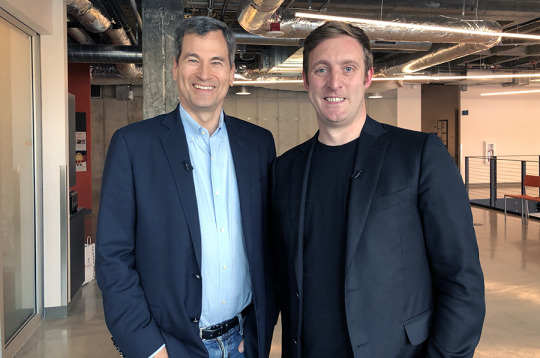The AWS Snowball can be a faster, cheaper way to send a company’s data to Amazon than uploading it.
POGUE: Snowball, you call it?
WOOD: It’s 100 terabytes of storage. And you just connect this up to your data center, load your data on. And then you just physically ship it back to us, and then we load it into the cloud from our data center.
POGUE: Ship it, like through FedEx or UPS or something—
WOOD: Exactly. You should never underestimate the bandwidth of a FedEx truck. (LAUGH) In fact, right on the front here, you can see that we have an e-ink display—basically, a Kindle—which shows the customer’s address when we ship it out to them. And then as soon as they arrive and plug it in, [the address on that screen changes to show] our data center collection location, and you just ship it back to us.
POGUE: Oh, this—this is a screen, this is not paper—
WOOD: Exactly, yes. Because we didn’t want the shipping labels to come off in transit.
POGUE: So essentially, this is like a giant shippable hard drive. Can you track it?
WOOD: Yeah; it has 3G, Wifi, and also a GPS system.
POGUE: But hard drives are delicate. What if the shipper guy drops it?
WOOD: We built them to be robust and ruggedized. We actually built them to military specifications. We put them on a boat in the middle of a lake and then exploded depth charges around the boat and then made sure they could still work.
POGUE: Can it handle a drop to concrete?
WOOD: Easily, no worries.
POGUE: Like this? (I shoved the Snowball off the table onto the concrete floor, where it just bounced and then lay flat) It’s okay, folks! It doesn’t have a scratch on it. I don’t know about the floor, though.
WOOD: (LAUGHS)
How AWS handles security
POGUE: OK, we gotta talk about security. I imagine you have a huge staff of experts?
WOOD: Yeah. I mean, security really is job zero for us. We take it extremely seriously. It’s the first thing that we think about when we get up in the morning, it’s the last thing we think about when we go to bed.
POGUE: Because “the cloud” actually resides in data centers—huge, unmarked buildings running thousands of servers. And one AWS data center may house the livelihoods of a bunch of companies, all concentrated in one building.
WOOD: Actually, we don’t even store all of the data in one place. We don’t have a single data center. We use groups of data centers. And those groups of data centers are separated by large distances. They’re on separate floodplains and fault lines. We move data automatically between the data centers in those groups. And that means the data is always backed up, not just inside a data center or between data centers, but between groups of data centers in different physical locations.
POGUE: So I don’t mean to give anyone ideas, but let’s say I figured out that one of these unmarked buildings was an AWS data center, and I blew it up. Are you saying that it’s so backed up and redundant that you probably wouldn’t notice?
WOOD: Yeah, you wouldn’t notice. I mean, we might be a bit upset, but you wouldn’t notice.
POGUE: That leads into my other question, which is that 70% of the cloud, 70% of the world’s internet traffic, flows through data centers in Loudoun County, Virginia. Should we be worried about that concentration?




